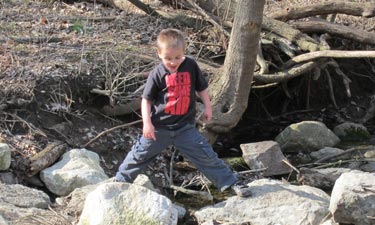 It was just a grapevine hanging from a live black cherry tree at Hills & Dales MetroPark’s nature play area. Children from the surrounding neighborhood turned these woods into a blur of activity as soon as school let out in summer. At the summit of Groundhog Hill, they built tepees and forts from honeysuckle limbs. Below the hill in the shallow spring-fed pond and creek the kids played with the cool rocks, minnows, and secret hiding places within the banks of the creek.
It was just a grapevine hanging from a live black cherry tree at Hills & Dales MetroPark’s nature play area. Children from the surrounding neighborhood turned these woods into a blur of activity as soon as school let out in summer. At the summit of Groundhog Hill, they built tepees and forts from honeysuckle limbs. Below the hill in the shallow spring-fed pond and creek the kids played with the cool rocks, minnows, and secret hiding places within the banks of the creek.
The grapevine, a perfect swing from one creek bank to the other, had become a hotly debated topic between youthful park-goers and park staff. Viewed alternately as an example of nature play at its finest and as a potential hazard, the decision was in: the vine would be cut down. However, what the park staff hadn’t anticipated was the frenzied opposition that ensued from the neighborhood children who had come to love their nature sanctuary. The kids posted signs daily in the nature play area. “Park Rangers, turn your chainsaws around!” “You can’t police every hazard in the woods!” “Stop taking away our fun!” What a wonderful moment to realize that these nature play test sites are working. These kids wanted their woods and they were willing to protect, advocate for, and fight for them!
Just six years earlier, the concept of nature play was taking shape around the country in response to the alarming research on the epidemic of nature deficit disorder in children. Five Rivers MetroParks in Dayton, Ohio, was at the forefront of implementation. With the full support of MetroParks’ leadership, a conscious organizational decision was made to develop five nature play sites in various parks in the district with a range of characteristics intended to give kids the opportunity to establish a personal connection to nature and give staff the ability to monitor the sites to see what worked.
Five Rivers MetroParks defined nature play as an unstructured outdoor experience in a natural environment, with minimal guidance of an adult, which cumulatively strengthens an individual’s personal connection to nature. MetroParks began promoting nature play for children and families at the five park locations. Efforts were both program and facility based and were grounded within the agency’s strategic goal of connecting children to nature in direct support of our mission as a conservation-based agency.
The predominance of media in our lives and a shift to highly supervised and structured childhood play and recreation has resulted in families with limited comfort or experience with nature and natural settings. MetroParks’s nature play sites and supporting programs were designed to reintroduce children and families to natural settings through exploration and development of outdoor skills. The goal of MetroParks nature play sites was to “graduate” participants to independent play and park use by reducing some of the prevalent psychological barriers (bugs, weather, don’t get muddy, etc.) and building confidence in being outdoors in an unstructured setting.
Access to natural areas for play is a common problem, and a philosophical switch on the part of agency leadership was necessary to allow kids to play in the park woods. This was an intentional departure from the traditional approach of instructing visitors to “stay on the trail” and “do not disturb nature.” In MetroParks’ nature play areas, kids are encouraged to manipulate rocks, sticks, sand, gravel, dirt, and water. Children exploring off-trail, overturning rocks and logs to find creatures and wading in creeks are common sights. The explorative and unstructured nature of this kind of play differs from traditional playground settings where large motor and social skills predominate.
Within FRMP there are five distinctly different established sites where nature play is promoted. The spectrum of opportunities ranges from “undeveloped,” minimal alterations to the site with materials such as rocks, sticks, and logs provided to encourage open-ended play, to more “developed” sites that are a hybridization of natural and artificial materials. Some important commonalities among sites include access to trees (standing or fallen), plants, shady forested areas, moving water, rocks, sticks, dirt, and proximity to residential neighborhoods. Drinking water, restrooms, and seating for adults are also significant elements.
Monitoring of these sites to judge how they are working is an ongoing process and so far most of the data is anecdotal. Five Rivers has a dedicated nature play committee which is developing plans for more methodical monitoring. This process will include a matrix for gauging success and partnerships with local universities to enlist graduate students for observation and data gathering research.
Along the course of this journey we’ve learned some valuable lessons. The rewarding response of the children protecting their grapevine tells us that giving youth access and invitation to play in the woods is creating budding conservationists and informed, impassioned stewards of the land.
Todd C. Catchpole is an Assistant Park Manager with Five Rivers MetroParks. Kimberly A. Catchpole is an extension educator with Ohio State University.

